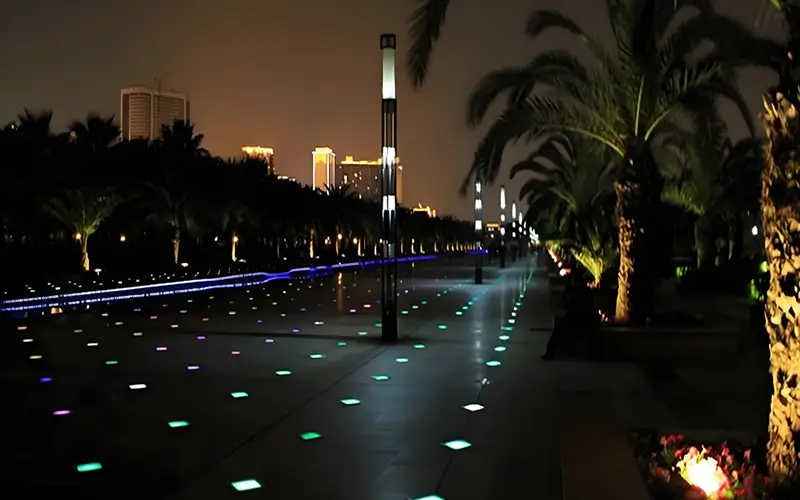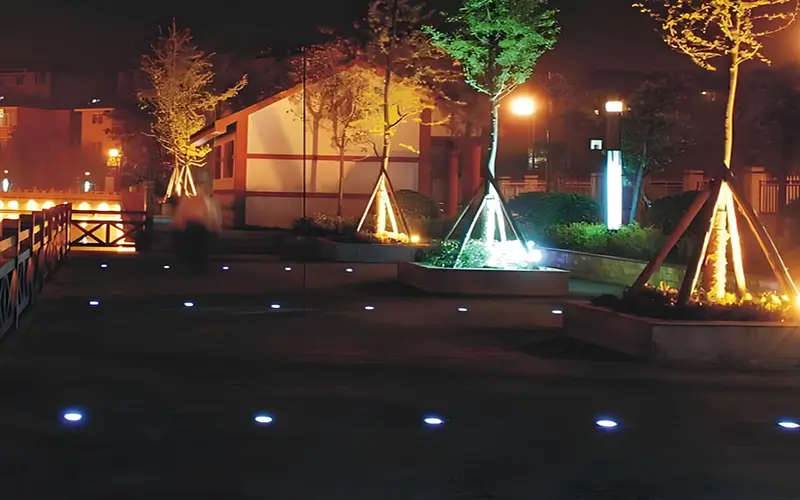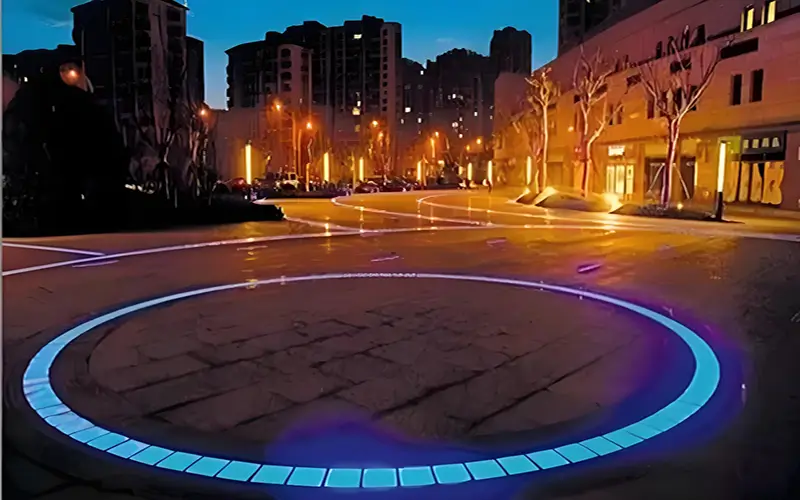
With the surge in demand for outdoor landscape lighting, LED underground lights have become common on the ground outdoors. We can see them in home lighting projects such as courtyard and trail lighting. But recently, some users have been concerned about their safety. They are worried about whether LED underground lights will cause heat or whether they can dissipate heat. If the surface temperature rises abnormally, are LED underground lights safe?
Will LED Underground Lights Generate Heat?
LEDs are semiconductor light-emitting bodies that generate a certain amount of heat when current passes through them. It is true that LED underground lights do generate heat during operation, but the heat generated is much smaller than that of traditional light sources.
However, if this heat cannot be effectively released, the temperature of the lamp body will rise, affecting its light efficiency and life. Generally speaking, the surface temperature of a normally working LED underground lamp is between 30-60℃, and the specific temperature depends on many factors.
There are many factors that affect its durability, such as LED chip quality, drive power design, heat dissipation structure, and ambient temperature. This temperature range usually does not cause danger to the surrounding environment, but it can still feel warm when touched.
What Causes LED Underground Lights to Heat Up?
Generally speaking, the heat emitted by LED underground lamps is very small. But we should also pay attention to its heating condition, so as to extend its service life.

1. The quality of the driving power supply
LED lamps need to be equipped with driving power supplies for constant current control and voltage conversion. The driving power supply will also consume some electrical energy during operation. If the quality of the power supply is not good, its conversion efficiency is low, and the loss is high, resulting in a large amount of electrical energy being released in the form of heat.
2. Unreasonable heat dissipation design
Since LED underground lamps are installed under the ground or in embedded structures, the heat dissipation space is extremely limited. Therefore, the lamp itself needs to use good thermal conductive materials (such as aluminum alloy and copper heat dissipation structure). If not, then the heat will be difficult to conduct to the outside in time, causing a local high temperature in the lamp body, affecting the stability of the LED chip and the light output.
3. Excessive sealing hinders heat release
Since LED underground lamps are used outdoors, a very strong sealing structure is required. Only in this way can the waterproof, dustproof and corrosion-resistant functions be achieved. Although these designs improve the protection level (such as reaching IP67 or IP68), they also restrict air flow and reduce the natural convection capacity of heat.
4. Influence of external ambient temperature
LED underground lights are often installed in outdoor environments and exposed to natural climates for a long time. In hot seasons or when installed in direct sunlight, the ambient temperature will increase the thermal burden of the lamp.
5. Long-term continuous operation
The longer the LED underground light works continuously, the more heat it accumulates and the temperature will rise accordingly. So pay attention to its usage time.
How Do LED Underground Lights Solve the Heat Dissipation Problem?
To solve the problem of heating, LED underground lamps also have many designs to solve the problem of heat dissipation. Of course, high-quality LED underground lamps usually adopt a variety of advanced heat dissipation designs:
Metal heat sink
High-quality LED underground lamps usually use materials with good thermal conductivity such as aluminum alloy as the lamp body and heat sink to quickly transfer heat from the LED chip.
Heat sink fin design
Design heat sink fins inside the lamp to increase the heat dissipation area and improve the heat dissipation efficiency. For some high-quality products, its heat sink fin design can increase the heat dissipation effect by more than 50%.
Heat pipe technology
Most high-end LED underground lamps use heat pipe technology, which uses the phase change principle to quickly transfer heat from the heat source to the heat dissipation area.
Heat conduction materials
Use high-efficiency heat conduction materials such as thermal grease and graphite sheets between the LED chip and the heat sink to reduce thermal resistance and improve heat conduction efficiency.
Bionic heat dissipation design
Drawing on the efficient heat dissipation structure in nature, such as the honeycomb and wave-shaped designs. Honeycomb design is more common, and it can improve the heat dissipation effect.
Separate design
The general design of LED underground lamps is to separate the heat-generating power supply part from the light source part to reduce the problems caused by the concentration of heat sources.
Ventilation hole design
On the premise of ensuring the waterproof level, the ventilation structure is cleverly designed to accelerate heat dissipation using the convection principle.
Will the Heating of LED Underground Lights Affect the Service Life?
The answer is yes. Temperature is one of the key factors affecting the life and performance of LED underground lamps. Excessive operating temperature will indeed have a significant impact on the service life of LED underground lamps.

1. High temperature promotes the light decay of LED chips
When LED light-emitting chips operate at high temperatures, their light decay rate will accelerate. After being lit for a long time, the LED chip itself will slowly decay. . If the chip junction temperature (the temperature inside the chip) continues to be too high, its crystal structure will be destroyed, resulting in reduced luminous efficiency.
2. Electronic components
LED underground lamps usually also contain electronic components such as drive power supplies, capacitors, inductors, and resistors. These components are very sensitive to temperature. So pay attention to temperature changes.
3. Aging and failure of sealing materials
Excessive temperature will accelerate the aging of materials such as silicone and sealants, reduce waterproof and dustproof performance, and ultimately cause the lamp to fail.
4. Color temperature drift affects lighting effects
In a high temperature environment, the wavelength of light emitted by an LED chip may change slightly, thus affecting its light color. For example, an LED that was originally 2700K (warm white light) may tend to be more yellow or blue after running at high temperatures, thus changing the original lighting atmosphere.
How to Choose High-quality LED Underground Lights?
To choose high-quality LED underground lights, we must first look at their heat dissipation performance. LED underground lights with excellent heat dissipation performance can be selected from the following aspects:
1. Check the material of the lamp body
The shell material of the LED underground lamp directly determines its heat dissipation efficiency. Common materials on the market include aluminum alloy, stainless steel and plastic.
It is best to choose aluminum alloy, which has the strongest thermal conductivity and the highest thermal conduction efficiency. It can not only effectively conduct the heat generated by the chip to the outside of the lamp body, but also has good corrosion resistance and strength.
2. Observe the heat dissipation structure
High-quality LED underground lights will have a special heat dissipation design in structure. For example, the outside of the lamp body is equipped with obvious heat dissipation fins, grooves or ventilation structures, which are conducive to air circulation and heat release.
3. Test products and certification
Heat dissipation is a technical job, which is closely related to the design ability, material selection standards and testing procedures of the manufacturer. At the same time, check whether the product has international certifications, such as CE, RoHS), IP test report so on.
4. Pay attention to the ratio of power to size
The higher the power of the LED underground lamp, the more heat it generates. If the power is high and the lamp body is small, the heat dissipation space is limited, and overheating is likely to occur.
5. Warranty and service support
Before buying, be sure to ask about the warranty period, which is generally 3-5 years. Generally speaking, the longer the warranty period, the more confident the manufacturer is in the durability and thermal stability of the product.
Another is the after-sales service system, such as providing technical consultation, installation guidance and even replacement services, so that users can have no worries.
How to Maintain LED Underground Lights to Prevent Overheating During Use?
The heat emitted by LED underground lights is very small, but we must also be careful not to let it continue to overheat. Because if it is overheated all the time, it will affect its performance and life.
Reasonable control of usage time
Although LED underground lights can be lit for a long time, it is also necessary to control the time of lighting. Because continuous work for too long may still cause the internal temperature to continue to rise due to heat accumulation.
It is recommended to equip with an automatic timing control system or light sensor to reasonably set the switching time according to actual needs to avoid ineffective operation.
Especially in hot areas, the surface temperature is already high. After continuous use for several hours, the internal temperature of the lamp may reach the limit, affecting the service life.
Regularly clean the lamp
Underground lights used outdoors for a long time will have a lot of dust and sand blocking it. So it should be cleaned in time. Because these coverings will seriously hinder the heat dissipation channel and even form a “heat island effect” to accelerate the temperature rise of the lamp body.
Check the installation environment
Although the underground lamp is embedded in the ground, the top or surrounding area should be covered with a lot of soil, grass or other objects that hinder the release of heat.
Check the electrical connection regularly
If the connection between the power cord and the lamp is loose, corroded or has poor contact, it will increase the resistance and generate additional heat, which is one of the common hidden dangers of the internal temperature rise of the underground lamp.
Summary
LED underground lights do generate heat, but their heat generation is much lower than that of traditional lighting equipment. However, you should also choose LED underground lamps with strong heat dissipation performance. Through reasonable heat dissipation design and material selection, the temperature can be controlled within a safe range.
In our use process, daily maintenance and proper use control can effectively prevent overheating problems and ensure long-term stable operation of the lamps.
We provide high-quality, low-heat, long-life LED underground lamp products and customised installation services to meet your various lighting needs. Welcome to contact us.
